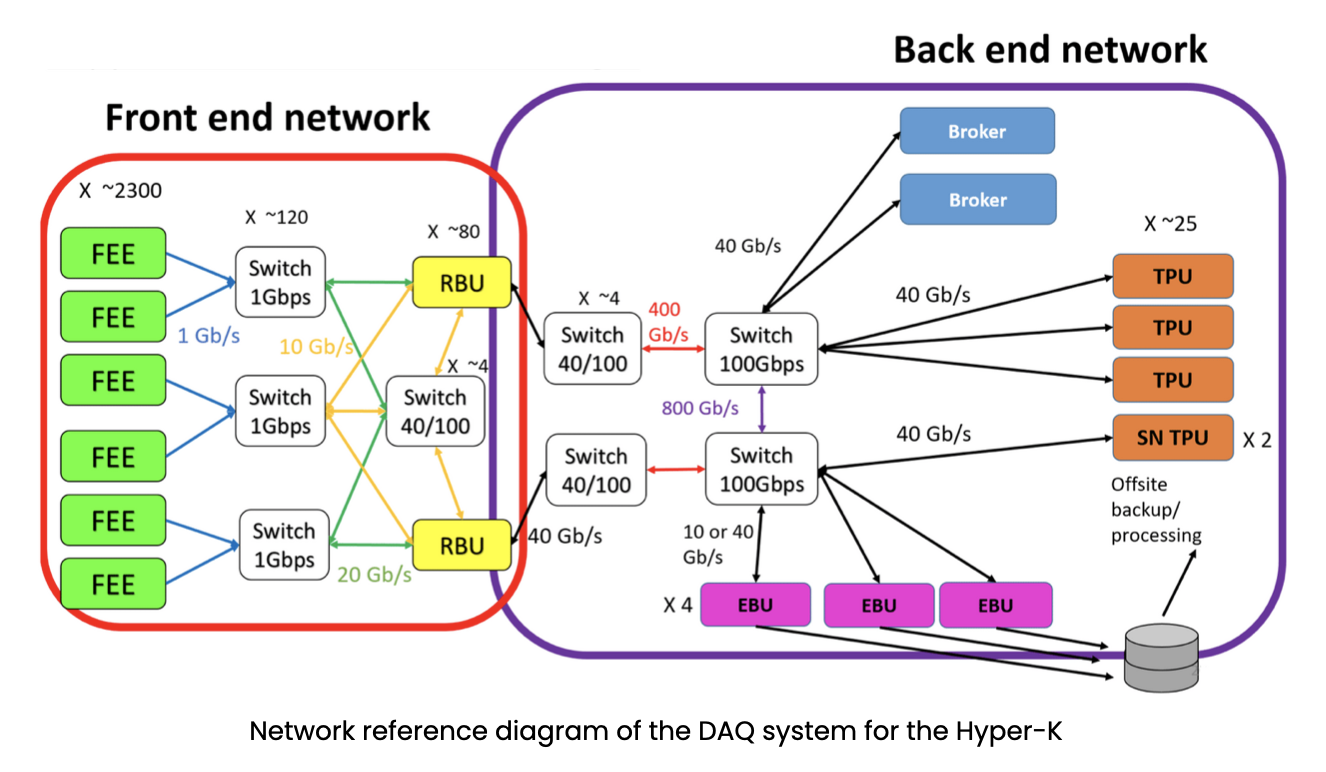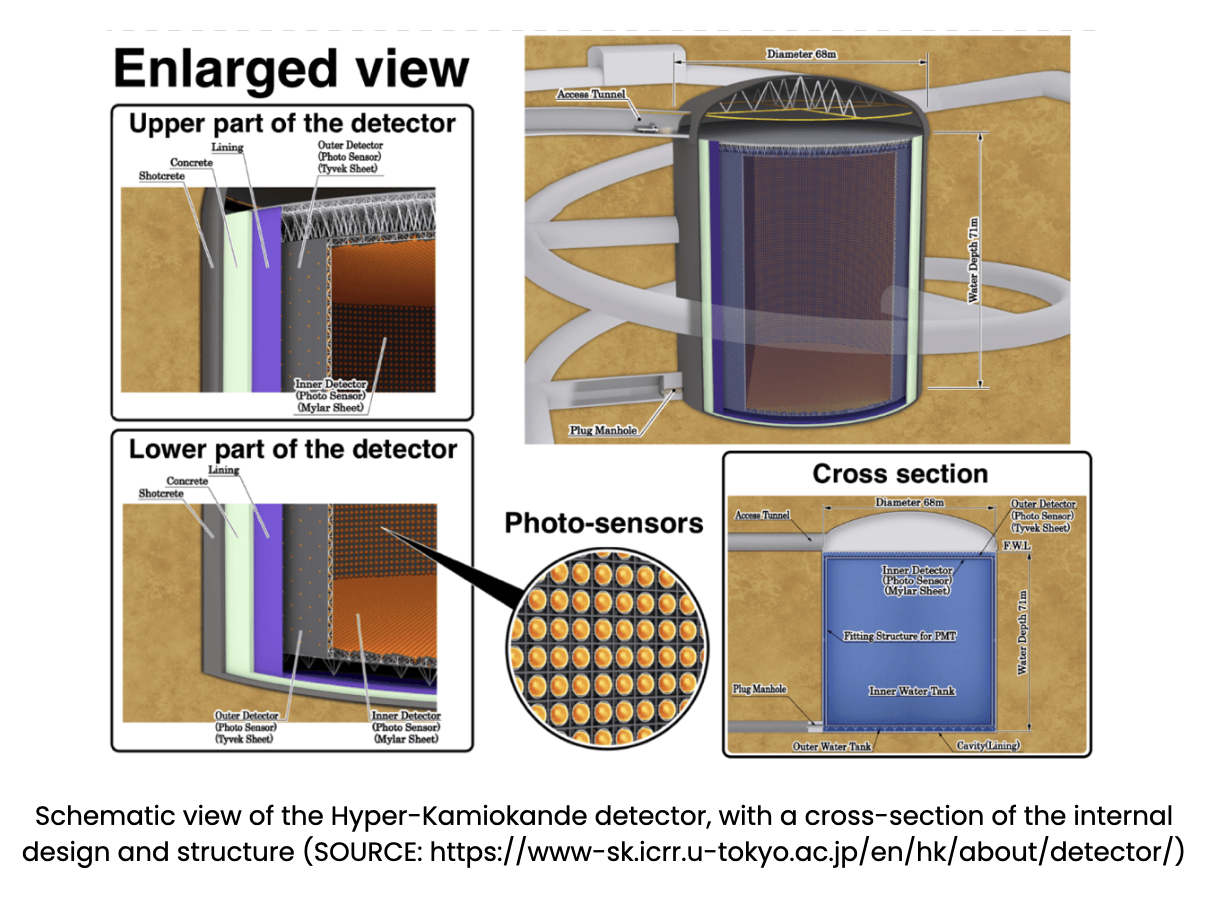Hyper-Kamiokande is a next-generation underground water Cherenkov detector based on the highly successful Super-Kamiokande experiment, which is due to start taking data in 2028.
It consists of a 71m by 68m cylindrical tank. The tank is filled with the equivalent of 80 olympic swimming pools, a volume approximately 8 times larger than that of Super-Kamiokande, of ultrapure water. On the walls of the tanks, 20,000 ultrasensitive photo-sensors are installed to detect the very weak Cherenkov light generated in the ultrapure water. Hyper-Kamiokande will serve as a far detector, 295 km away, of a long baseline neutrino experiment for the upgraded J-PARC beam. It is being built to investigate a broader range of neutrino properties and phenomena with unprecedented precision. It is hoped that it will be able to determine the value of the very important ChargeParity violating phase which is a crucial question in leptonic physics. Furthermore, it will be able to observe and measure the properties of solar neutrinos, atmospheric neutrinos, geo-neutrinos, cosmic neutrinos from supernova explosions and proton decay if the latter happens in nature.
PPD INVOLVEMENTS:
DAQ SYSTEM
 One of the most important tasks PPD is working on is the DAQ system. The Hyper-K DAQ faces some real challenges, one of which is to be able to identify and trigger events that are as low in energy as possible, only a few MeV in energy (as low as even 2MeV, which only generates a few hits in the detector, essentially indistinguishable from background dark noise hits). This will give Hyper-K access to more physics, pushing the boundaries of what was thought possible in such an experiment. At the same time, the DAQ system has to be built for taking data up to 24 hours: given the rarity of supernovae, it cannot be afforded to have dead time and miss valuable messenger neutrinos from far away that could tell us more about the physics involved and the neutrinos themselves.
One of the most important tasks PPD is working on is the DAQ system. The Hyper-K DAQ faces some real challenges, one of which is to be able to identify and trigger events that are as low in energy as possible, only a few MeV in energy (as low as even 2MeV, which only generates a few hits in the detector, essentially indistinguishable from background dark noise hits). This will give Hyper-K access to more physics, pushing the boundaries of what was thought possible in such an experiment. At the same time, the DAQ system has to be built for taking data up to 24 hours: given the rarity of supernovae, it cannot be afforded to have dead time and miss valuable messenger neutrinos from far away that could tell us more about the physics involved and the neutrinos themselves.
The Hyper-K DAQ group at RAL is also working on estimating what the maximal expected rates will be in the Hyper-K detectors (both inner detector and outer detector) such that the DAQ system is able to cope with the incoming data.
LOW-ENERGY TRIGGERS
PPD has been designing several low-energy triggers (Nova), whose job is to distinguish in real-time electrons from a neutrino from those generated by random dark hits and radioactivity. The triggers include a simple trigger based on the number of hits, a high-performance test vertices trigger (based on time-of-flight correction), a trigger that looks for local clusters of hits in space and time and a trigger that reconstructs in real time the position in the sky of an exploding supernova. A high speed of execution is attained by running parallel computations on GPUs.
OUTER DETECTOR
RAL is currently involved in the PMT and wavelength-shifting (WLS) plate hardware effort for the Hyper-K outer detector (OD), a veto shield detector separated from the all-important inner detector by a light-tight membrane, with PMTs

pointing outwards, to be able to veto events that are caused by cosmic rays. The OD is absolutely crucial for the success of the experiment and is a very important part of the UK Hyper-K effort. With a dedicated lab at RAL, the group involved is able to evaluate OD PMTs and WLS plates, which is necessary for the optimisation of the detector design. In addition, it is planned to build a Hyper-K mock frame in a second lab to allow Hyper-K collaborators from all over the UK to evaluate various components and practice assembly tasks for the final construction of the detector.
In terms of optimising the OD detector design, it has been carried out much significant software and analysis work, designing the PMT/WLS combination and preparing a multitude of GEANT4 simulations to evaluate different scenarios throughout the development of the OD design to inform the decisions taken. Extensive work has been performed to allow the simulation of radioactive decay in the detector and to study the impact of all-natural radioactivity isotopes that may contaminate the glass of the photomultiplier bulb.
